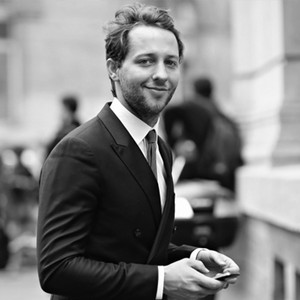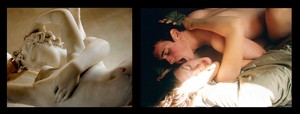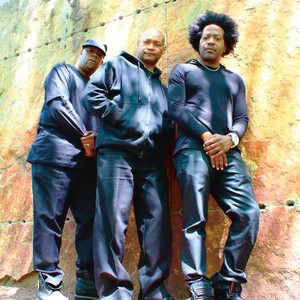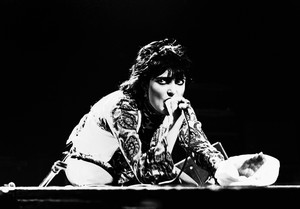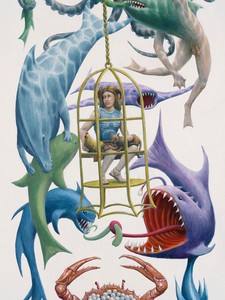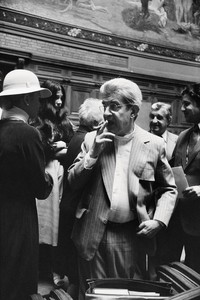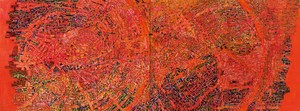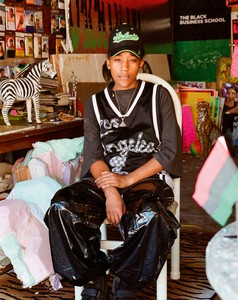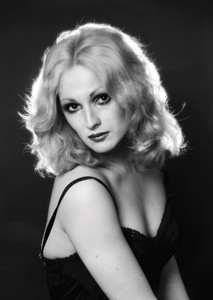Nan Goldin’s exhibition Scopophilia closed last week in Rome. As the pictures come down and are dispersed into collections and museums around the world, it marks a special moment in the career of the photographer and artist. This show was composed of the artist’s most recent series, where she combined select photographs from her archives and contrasted them against her images of paintings and sculptures, taken during her visit to the Louvre’s collections.
The Greek term scopophilia literally means “love of looking,” but also refers to the erotic pleasure derived from gazing at images of the body. This show began when Goldin was given private access to Paris’ Louvre Museum every Tuesday. There, she wandered and photographed freely throughout the museum’s renowned collections of painting and sculpture. The pieces she was drawn to feature the same themes that show up in her photography: sex, violence, rapture, despair, and the mutability of gender. Using digital technology—a new experience that initially felt foreign to Goldin, something we’ll delve into further in a minute—she created a slideshow that combined her new pictures of the Louvre’s antiquities with pictures from her own four-decade archive. The result was a brilliant discussion between the past and the present.
Years ago, if you were to ask Goldin whether she would ever update her creative process to incorporate digital tools, she would have balked at the question. But as cameras that record on film have evolved and grown archaic, Goldin grew anxious of her medium. As she told the MAXXI Museum when she opened the show in Rome, “I printed with Cibachrome, and none of those exist anymore. It was all analog until a few years ago and then I could no longer find my medium; it’s as if oil paint was taken away from painters and they were forced to paint with acrylics.” According to Gagosian’s Bob Monk, who put together the show in Rome and remembers working with Nan back in the 1970s and 1980s, she loved traditional photographic techniques, like dye transfers and Cibachrome printing. She relished the process of creating vibrant colors with a romantic, tragic sheen. Says Goldin, “I usually like to change images at the last second, for me it was hard to adapt to the digital era. I used to deal with physical pictures, to actually physically handle them.”
As her studio began to digitize her archives, lightning struck. She realized that she could quickly, efficiently scan her entire archive, in a single sitting, on a computer screen. She recognized the duality between her work and the work of the painters and sculptors who had come before her. Artists who had captured the likes of Psyche and Cupid on canvas, or in marble, and who had inspired viewers for centuries. Through digital technology she was able to create an entirely new dialogue between past and present. “When I was alone in the museum I would find paintings and fall completely in love. That was the beginning, then I started to see my friends. I started to see my lovers. I started to find the myths and I became fascinated to see how they relate to the history of humanity. Then we found lots of old pictures of mine, from the 1970s through 2011, which related to the pictures that I’d fallen in love with [at the Louvre].” The result was a series of collages that not only inspire, but that speak to each other. The ecstasy of love that we see in an eighteenth-century statue, which Goldin photographed at the Louvre in 2010, reflects and enhances the ecstasy of love we see in a softly lit couple that Goldin photographed in the 1980s. Love, as well as pain, sex, and even drug use, are common ties throughout her work, and common to art throughout history.
In the end, her reluctant embrace of modern photographic methods added a new dimension to her career. “What’s so remarkable about the works in Rome, why they are so beautiful, is that even though she is recognized as a great artist, she is also still evolving,” Monk explains. “She continues moving forward, pushing her own experience.” The show in Rome premiered several new works that are wonderful illustrations of her increasingly masterful gaze.
Nan Goldin has left us inspired by her visit to the Louvre and by the people who have entered her life and been in front of her lens. She has said “There are pictures of the people that I’ve fallen in love with in the Louvre.”


